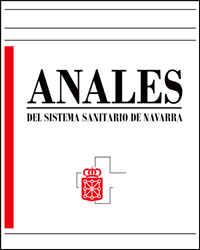Síndrome de Paget-Schroetter asociado a hiperhomocisteinemia
Palabras clave:
Trombosis venosa de extremidades superiores, Síndrome de Paget-Schroetter, Trombofilia, HiperhomocisteínaResumen
La enfermedad tromboembólica venosa (ETEV) en extremidades superiores es una entidad poco frecuente, si bien su incidencia ha aumentado en relación con el empleo de catéteres venosos centrales. La etiología puede ser primaria (idiopática, espontánea, de esfuerzo o traumática) o secundaria (relacionada con tumores, catéteres venosos centrales, etc.). Presentamos un caso de trombosis venosa primaria de extremidad superior derecha, también llamada síndrome de Paget-Schroetter. Este cuadro suele asociarse a ejercicios o esfuerzos intensos y/o repetitivos de la extremidad afecta, alteraciones anatómicas en la zona, o bien puede ser la primera manifestación de un estado trombofílico desconocido hasta ese momento, como en el caso que nos ocupa. La clínica suele consistir en dolor en extremidad afecta, acompañado frecuentemente de edema y circulación colateral. La ecografía-doppler presenta con frecuencia falsos negativos, recomendando la realización de TAC por su mayor especificidad y para valoración de las estructuras vecinas, aunque la flebografía continúa siendo la prueba oro para el diagnóstico de este cuadro. No existe unanimidad acerca del tratamiento, recomendándose individualizar de acuerdo con las características propias de cada caso.Descargas
Descargas
Publicado
Cómo citar
Número
Sección
Licencia
La revista Anales del Sistema Sanitario de Navarra es publicada por el Departamento de Salud del Gobierno de Navarra (España), quien conserva los derechos patrimoniales (copyright ) sobre el artículo publicado y favorece y permite la difusión del mismo bajo licencia Creative Commons Reconocimiento-CompartirIgual 4.0 Internacional (CC BY-SA 4.0). Esta licencia permite copiar, usar, difundir, transmitir y exponer públicamente el artículo, siempre que siempre que se cite la autoría y la publicación inicial en Anales del Sistema Sanitario de Navarra, y se distinga la existencia de esta licencia de uso.








